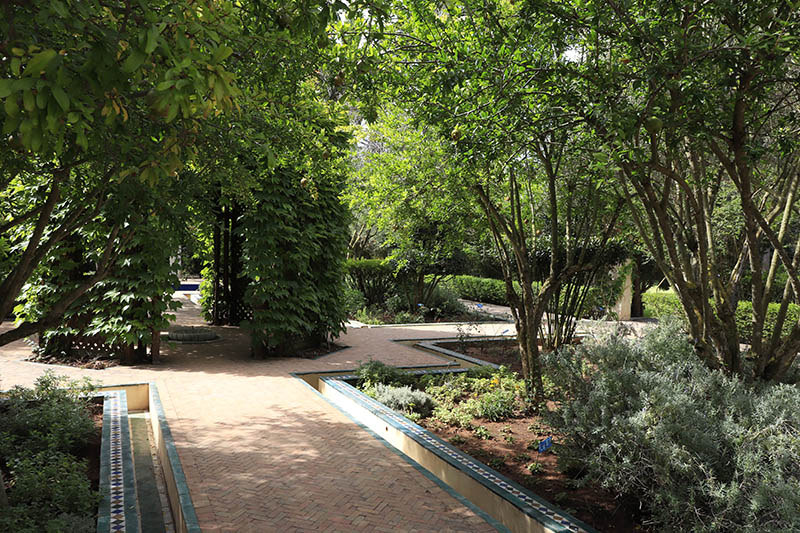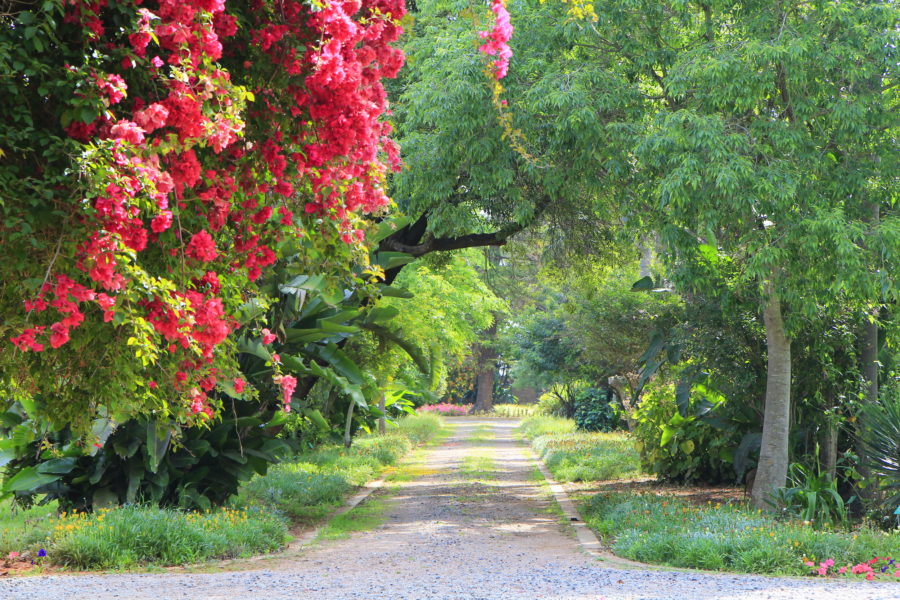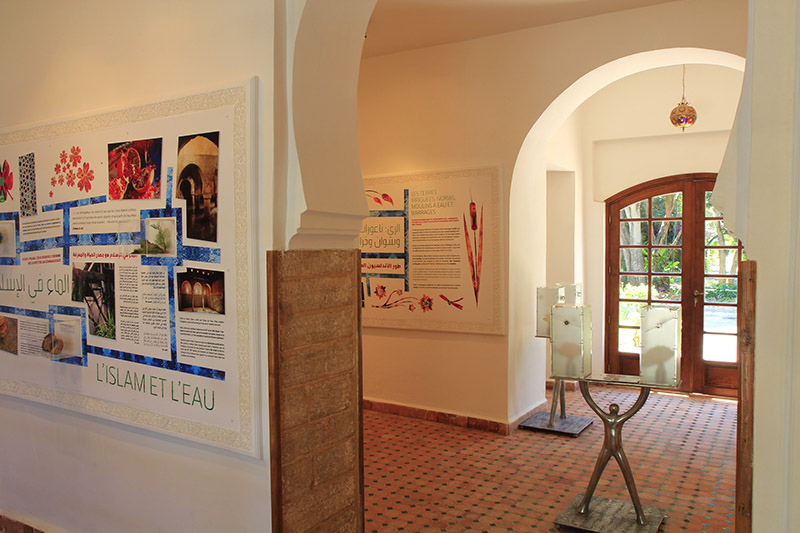Rabat’s Acclimatisation Garden
The Rabat Acclimatisation Garden (Jardin d’Essais Botaniques, JEB) was inaugurated in 2013, in the presence of the King of Morocco, Mohammed V, following its first rehabilitation after years of neglect since its creation at the beginning of the 20th century. At its heart was the Andalusian-style garden designed by the Islamic Culture Foundation (FUNCI) and the minzah, or recreation pavilion.
Rabat’s acclimatisation garden is a beautiful space of shade and silence spread over 17 hectares in the most populous centre of the Alawi capital. It was designed by the great French landscape and urban planner Jean-Claude Nicolas Forestier. Forestier worked on urban extensions and designed numerous green spaces, mainly in Morocco, France and Spain, where he was the architect of the Maria Luisa Park in Seville, the Moorish King’s Garden in Ronda and the gardens of the Moratalla Palace in Hornachuelos, among other memorable works.
The JEB, or Rabat acclimatisation garden, has always been associated with INRA, the Moroccan National Institute for Scientific Research, and the purpose of its creation was to introduce and acclimatise various exotic species of economic and ornamental interest.
The JEB, or Rabat acclimatisation garden, has always been associated with INRA, the Moroccan National Institute for Scientific Research, and the purpose of its creation was to introduce and acclimatise various exotic species of economic and ornamental interest. It is part of the perimeter declared a UNESCO World Heritage Site in 2012. It currently houses around 650 botanical species. The Arboretum has a great diversity, consisting of 27 families divided into 44 species.
There are large avenues flanked by old ficus trees, flowerbeds dedicated to collections of palms, fruit trees and succulents, and paths along which you can lose yourself among the overwhelming vegetation and avenues sheltered by canopies of plants.
A FUNCI – INRA agreement
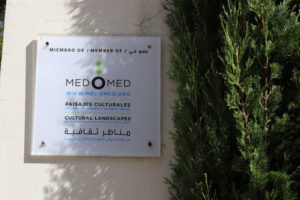 In 2007, INRA signed an agreement with FUNCI, in the framework of its international development network “Med-O-Med, Cultural Landscapes of the Mediterranean and the Middle East”, for the creation of a new Andalusian-style garden on one of the JEB plots. It also commissioned the restoration of the adjoining recreation pavilion, a beautiful building embroidered with sandstone in the Maghreb-Andalusian style. The project was carried out by two FUNCI collaborators: the well-known architect specialising in Islamic art, Antonio Almagro Gorbea, and the agronomist and expert in Andalusian botany and author of several books on the subject, Esteban Hernández Bermejo. The work was carried out with the help of the technical architect Faissal Cherradi, restorer, among other things, of the Almohad minaret “Tour Hassan” in Rabat.
In 2007, INRA signed an agreement with FUNCI, in the framework of its international development network “Med-O-Med, Cultural Landscapes of the Mediterranean and the Middle East”, for the creation of a new Andalusian-style garden on one of the JEB plots. It also commissioned the restoration of the adjoining recreation pavilion, a beautiful building embroidered with sandstone in the Maghreb-Andalusian style. The project was carried out by two FUNCI collaborators: the well-known architect specialising in Islamic art, Antonio Almagro Gorbea, and the agronomist and expert in Andalusian botany and author of several books on the subject, Esteban Hernández Bermejo. The work was carried out with the help of the technical architect Faissal Cherradi, restorer, among other things, of the Almohad minaret “Tour Hassan” in Rabat.
 The Royal inauguration of the acclimatisation garden, after its first restoration, was followed by another period of slow deterioration, which forced a new intervention.
The Royal inauguration of the acclimatisation garden, after its first restoration, was followed by another period of slow deterioration, which forced a new intervention.
In 2007, INRA signed an agreement with FUNCI, in the framework of its international development network “Med-O-Med, Cultural Landscapes of the Mediterranean and the Middle East”, for the creation of a new Andalusian-style garden on one of the JEB plots.
Today, the JEB, and with it the Andalusian garden, is once again in full bloom, with new squares and layouts, plant enrichment by INRA and the restoration of the beautiful large ponds by Forestier, to the delight of the public. The work, which has not yet been completed, is being carried out by the veteran landscape architecture studio Carey Duncan Design.
The Andalusian Garden
The Andalusian-inspired garden conceived by FUNCI rigorously follows certain stylistic parameters that are found simultaneously in the historic Hispano-Arabic and Moroccan gardens of medieval origin.
Its layout corresponds to the idea of the interior courtyard of a house, in the Almohad style, with a quadrangular shape and a cross-shaped layout. The two intersecting elements are small terraces lined with water channels, which make up the four plantation areas.
 Water appears as an important element in the form of two ponds in front of the side pavilions, in the form of sheets which reflect the sky and create an effect of depth, disturbed only by small fountains. The garden also has low basin fountains with gurgling water that frame the central space crowned by an evocative kiosk covered with greenery, and penetrate into the interior of the pavilions.
Water appears as an important element in the form of two ponds in front of the side pavilions, in the form of sheets which reflect the sky and create an effect of depth, disturbed only by small fountains. The garden also has low basin fountains with gurgling water that frame the central space crowned by an evocative kiosk covered with greenery, and penetrate into the interior of the pavilions.
The Andalusian-inspired garden conceived by FUNCI rigorously follows certain stylistic parameters that are found simultaneously in the historic Hispano-Arabic and Moroccan gardens of medieval origin.
The original botanical collection, some of which has disappeared, is gradually being restored. It includes climbers such as roses, jasmine and Virginia creeper, bulbs such as iris, daffodils and lilies, aromatic plants, violets, wallflowers, chrysanthemums and roses, among others.
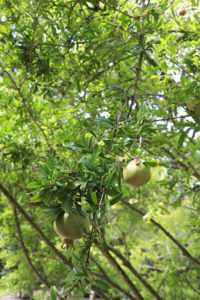 Since its creation, the trees have grown – pomegranates, laurels in the form of topiary and olive trees – as have the species featured on the metal arched enclosures: cypresses, myrtles and jasmines, providing welcome shade and shelter for countless songbirds and butterflies.
Since its creation, the trees have grown – pomegranates, laurels in the form of topiary and olive trees – as have the species featured on the metal arched enclosures: cypresses, myrtles and jasmines, providing welcome shade and shelter for countless songbirds and butterflies.
The recreation pavilion, known locally as the “Maison mauresque”, completes the complex. FUNCI installed a small museum on water in al-Andalus.
Various panels in four languages illustrate the role of water in Islamic gardens, the garden as a spiritual metaphor, the scientific garden and the poetic garden, which refers to the genre known in the Middle Ages as Rawdiyat and Nawriyat, with a vast production of poems with vegetal and landscape content.
The recreation pavilion
The recreation pavilion, known locally as the “Maison mauresque”, completes the complex. FUNCI installed a small museum on water in al-Andalus, based on the book “The Enigma of Water in Al-Andalus”, by Cherif Abderrahman Jah, President of FUNCI, published twice by Lunwerg. The delightful museum, designed by Miguel Ripoll, abounds in written, olfactory and audiovisual documentation on the institutions that distributed water, the distribution and irrigation devices and the cultural importance of this precious element in Islam.
After this new intervention, which has only just begun, FUNCI, in collaboration with INRA and the Wilaya of Rabat, Salé, Kenitra, on whom the management and maintenance also depend, has regained the enthusiasm to open and offer this beautiful space to the public, students and associations, for their enjoyment and to promote knowledge of one of the “greenest” and most fertile periods of history.
Islamic Culture Foundation
Photography: Inés Eléxpuru
This post is available in: English Español


